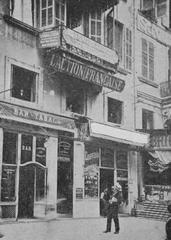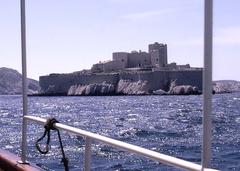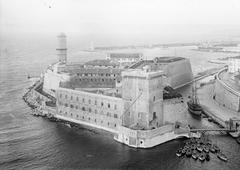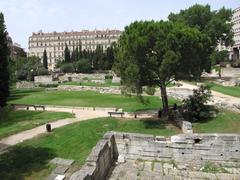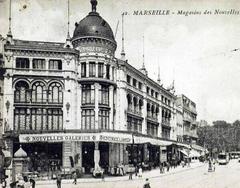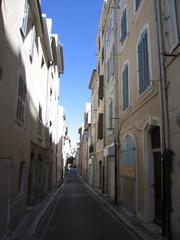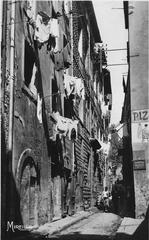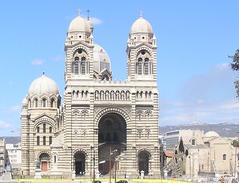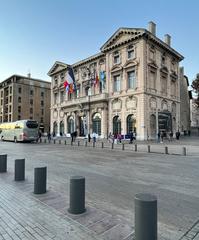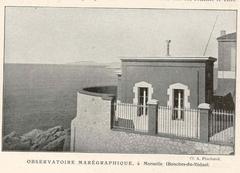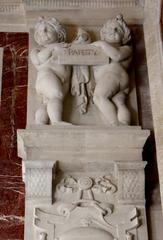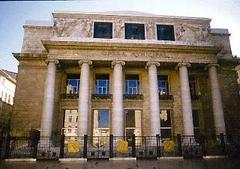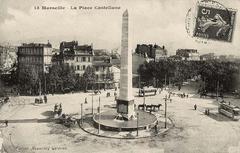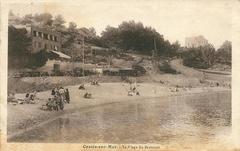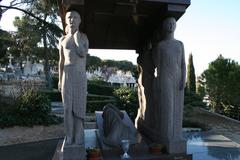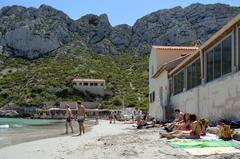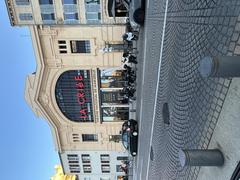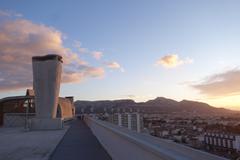Saint-Pierre Marseille Visiting Hours, Tickets, and Historical Sites Guide
Date: 04/07/2025
Introduction to Saint-Pierre Marseille: Visitor Information and Cultural Significance
Nestled within the vibrant city of Marseille, the Saint-Pierre district stands as a captivating blend of rich history, cultural diversity, and authentic Provençal life. Recognized as one of Marseille’s most historically significant neighborhoods, Saint-Pierre offers an immersive experience that extends beyond the city’s famed Vieux-Port and Le Panier districts. Founded in the wake of Marseille’s ancient Greek origins (circa 600 BCE), Saint-Pierre evolved through centuries of urbanization, shaped by 19th-century industrial growth and post-war multicultural development (Nomadic Matt; PlanetWare).
At its heart are landmarks such as the neo-Romanesque Saint-Pierre Church, built in 1858, and the expansive Saint-Pierre Cemetery—established in 1855 and among France’s largest cemeteries—renowned for its funerary art and as the resting place of many notable figures (Marseille Tourisme; marseille.fr). This guide details visiting hours, ticketing (with free entry to major sites), accessibility, and cultural highlights to help travelers explore Saint-Pierre with confidence.
Beyond its historical treasures, Saint-Pierre thrives as a lively neighborhood, featuring authentic local markets, diverse dining options with Provençal and Mediterranean flavors, and vibrant community events that celebrate Marseille’s multicultural fabric (France Rent; Marseille Tourisme). With convenient public transport and pedestrian-friendly streets, Saint-Pierre invites visitors to discover the soul of Marseille, past and present.
Contents
- Introduction
- Historical Evolution of Saint-Pierre
- Key Historical Sites and Visiting Information
- Tickets, Tours, and Accessibility
- How to Get There and Around
- Cultural Experiences and Local Events
- Dining and Nightlife
- Safety Tips and Visitor Etiquette
- FAQ
- Visuals and Maps
- Conclusion and Call to Action
Historical Evolution of Saint-Pierre
Ancient Origins and Development
Saint-Pierre, a district in Marseille—the oldest city in France—has roots reaching back to the city’s Greek foundation (Nomadic Matt). While the Vieux-Port remains Marseille’s iconic heart, Saint-Pierre developed as the city expanded eastward, evolving from rural outskirts to an urban neighborhood throughout the 19th and 20th centuries. The area is named after the historic Church of Saint-Pierre, a focal point in the district’s growth.
19th and 20th Century Urbanization
The 19th century industrial boom and Marseille’s port activities accelerated Saint-Pierre’s integration into the city. The Cimetière Saint-Pierre, established in 1855, is now Marseille’s largest cemetery, open daily from 8:00 AM to 6:00 PM with free entry (France Rent). The advent of railway and tram connections transformed Saint-Pierre into a bustling residential and commercial area.
Post-War Expansion and Modern Identity
Following World War II, waves of immigration from North Africa and Southern Europe shaped Saint-Pierre into a multicultural hub, reflecting Marseille’s broader diversity (PlanetWare). Today, Saint-Pierre is a district where Provençal culture blends with Mediterranean and North African influences.
Key Historical Sites and Visiting Information
Saint-Pierre Church
The neo-Romanesque Saint-Pierre Church, built in 1858, stands as a spiritual and architectural landmark. Open Monday through Saturday, 9:00 AM to 12:00 PM and 2:00 PM to 6:00 PM, the church welcomes visitors free of charge (donations appreciated). Guided tours can be arranged via the parish office (Marseille Tourisme).
Cimetière Saint-Pierre
Spanning 63 hectares, the Saint-Pierre Cemetery is one of France’s largest and most architecturally significant cemeteries (marseille.fr). Established in 1855, it is open daily from 8:00 AM to 6:00 PM, with free entry. The cemetery is renowned for its artistic mausoleums and notable burials. Audio guides and guided tours are available during special events such as European Heritage Days.
Nearby Historical Attractions
Saint-Pierre is conveniently located near major Marseille landmarks, including the Vieux-Port, Le Panier district, and Palais Longchamp, all accessible by public transport within 15 minutes.
Tickets, Tours, and Accessibility
- Entry Fees: Most sites, including the church and cemetery, are free to visit.
- Guided Tours: Local operators offer walking tours highlighting Saint-Pierre’s history and multicultural heritage. Advance booking is recommended through official tourism platforms.
- Accessibility: The district features paved sidewalks and ramps. The church and most public areas are wheelchair accessible, though some older buildings and cemetery sections may present challenges. Public transport is equipped for mobility-impaired visitors.
How to Get There and Around
- Public Transport: Saint-Pierre is accessible via Marseille Metro Line 1 (La Timone and Saint-Barnabé stations) and multiple bus routes (Nomadic Matt).
- Car: Parking is limited; public transport is advised.
- Walking & Cycling: Pedestrian-friendly streets and bike lanes connect Saint-Pierre with neighboring districts.
Cultural Experiences and Local Events
Saint-Pierre hosts diverse community events, from multicultural music festivals to local celebrations, reflecting its vibrant identity. Residents actively participate in citywide festivities such as the Fiesta des Suds and Bastille Day (Marseille Tourisme).
Dining and Nightlife
The district’s culinary scene includes Provençal bistros, North African bakeries, and Italian trattorias. Must-try dishes are bouillabaisse, couscous, and panisse (France Rent). Nightlife is relaxed, with cozy bars and occasional live music venues.
Safety Tips and Visitor Etiquette
- Saint-Pierre is generally safe; observe typical city precautions.
- French is the main language; Arabic and Italian are also spoken.
- Optimal visiting seasons: Spring (April–June) and Autumn (September–October) (Iroamly).
- Dress modestly at religious sites and greet locals courteously.
FAQ
Q: What are the visiting hours for Saint-Pierre’s main sites?
A: The Church of Saint-Pierre is open Monday–Saturday, 9 AM–12 PM and 2 PM–6 PM; Cimetière Saint-Pierre is open daily, 8 AM–6 PM.
Q: Is there an entry fee?
A: No, both the church and cemetery are free to visit.
Q: Are guided tours available?
A: Yes, tours can be booked through official tourism channels or local operators.
Q: How can I reach Saint-Pierre from central Marseille?
A: Via Metro Line 1, bus, or by foot/bike from the city center.
Q: Is Saint-Pierre accessible for visitors with mobility issues?
A: Most areas are accessible, though some older streets and cemetery sections may be challenging.
Visuals and Maps
Enhance your visit with interactive maps and photo galleries on official Marseille tourism platforms. Descriptive alt text, such as “Saint-Pierre Marseille historical church” or “Cimetière Saint-Pierre entrance,” supports accessibility and user engagement.
Conclusion and Call to Action
Saint-Pierre offers a unique fusion of history, culture, and authentic Marseille life. Check updated visiting hours and book guided tours via official channels. For an immersive experience, download the Audiala app for audio guides, and follow us on social media for the latest events and travel tips.
Explore Saint-Pierre and discover the heart of Marseille beyond its most famous landmarks!
Visiting Saint-Pierre Cemetery in Marseille: Hours, Tickets, and Local Attractions
The Saint-Pierre Cemetery is the centerpiece of the district, drawing visitors for its monumental heritage and artistic significance. Established in 1855 and covering 63 hectares, it is Marseille’s largest cemetery and one of France’s most important burial sites (marseille.fr). Designed by Sixte Rey, the cemetery incorporates gardens of former bastides and features elaborate mausoleums, ornate tombstones, and funerary sculptures that reflect the city’s diverse cultural backgrounds.
Visiting Hours and Tickets
- Open: Daily, 8:00 AM–6:00 PM (seasonal variations possible; consult official site for updates).
- Tickets: Free entry.
- Guided Tours: Offered during heritage events and on request.
Accessibility
Most public areas are wheelchair accessible, though some older sections have uneven terrain.
Architectural and Artistic Highlights
The cemetery showcases 19th- and 20th-century funerary art in diverse styles, including neoclassical and Art Deco. Sections dedicated to Catholic, Protestant, Jewish, and Armenian graves mirror Marseille’s cosmopolitan heritage.
Local Life and Experiences
Beyond the cemetery, Saint-Pierre is a lively neighborhood with bakeries, shops, and parks. Local markets and cafés along Rue Saint-Pierre and Boulevard Sakakini offer authentic Marseille experiences.
Cultural Venues and Events
Nearby venues include Le Dôme concert hall and annual citywide festivals such as the Printemps de l’Art Contemporain and Biennale Internationale des Arts du Cirque (marseille.evous.fr).
Gastronomy and Markets
Saint-Pierre’s markets showcase fresh produce and regional specialties. The SAVIM Spring Fair at Parc Chanot features gourmet foods and fine wines (marseille.evous.fr).
Festivals and Nightlife
The district offers access to celebrated festivals such as Marsatac and Delta Festival (marseillesecrete.com). Jazz enthusiasts can enjoy the Marseille Jazz des cinq continents festival.
Parks and Outdoor Activities
Nearby parks such as Parc du 26e Centenaire and Parc Borély offer green spaces for relaxation. The Calanques National Park provides hiking and nature activities within easy reach (timeout.com).
Getting There
Saint-Pierre is accessible by bus, tram, and is a short ride from the Saint-Charles train station and city center.
FAQ
- Hours? 8:00 AM–6:00 PM daily; check the official site for updates.
- Fee? Free entry.
- Tours? Mainly during special events; inquire locally.
- Accessibility? Most public areas are accessible.
Visuals
Interactive maps and images are available on official tourism sites to assist in planning.
Discovering Notre-Dame de la Garde: Visiting Hours, Tickets, and Cultural Significance
Perched atop Marseille’s highest point, Notre-Dame de la Garde is a city icon and spiritual beacon. Built between 1853 and 1864 in Neo-Byzantine style, it offers panoramic views and a deep connection to Marseille’s maritime heritage (Notre-Dame de la Garde official website).
- Hours: 7:00 AM–7:00 PM (summer); 7:00 AM–6:00 PM (winter)
- Entry: Free; some guided tours or tower access may require a fee.
- Accessibility: Reachable by car, taxi, tourist train, or on foot (steep path); facilities for reduced mobility.
Highlights
- Panoramic terrace with views of the city and Mediterranean
- Intricate mosaics and ex-voto collections
- Proximity to Vieux-Port, MuCEM, and Le Panier
Tips
- Visit early or late for best light and fewer crowds
- Use public transport or the tourist train; walking is possible but steep
FAQ
- Entry fee? Free; some tours/tower access may have a fee.
- Transport? Bus, tourist train, or car.
- Accessibility? Yes, with ramps and facilities.
Discovering Saint-Pierre Church: Visiting Hours, History, and Practical Tips
Located in the 5th arrondissement, the neo-Romanesque Saint-Pierre Church (1858) is a key district landmark. Its rounded arches, intricate stonework, and proximity to the historic cemetery make it a highlight for visitors.
- Hours: 9:00 AM–6:00 PM daily (may vary during holidays/events)
- Entry: Free
- Tours: Occasionally available; check local listings or Marseille Tourisme
Getting There
- Metro: La Timone (Line 1), 10-minute walk
- Bus: Several lines along Rue Saint-Pierre and Boulevard Chave
- Parking: Limited; public lots recommended
Tips
- Use basic French phrases for a better experience
- Explore nearby markets, bakeries, and shops
- Take photos of the church façade and stained glass, especially in morning or late afternoon light
Safety
- Use standard city precautions
- Secure belongings, especially in crowded areas
FAQ
- Entry fee? Free
- Tours? Occasionally; check locally
- Attend mass? Yes, visitors are welcome at services
- Accessibility? Main access is generally accessible; some limitations may apply
Summary: Key Points for Visiting Saint-Pierre Marseille
Saint-Pierre is ideal for those seeking Marseille’s layered history, vibrant culture, and authentic local life. From the neo-Romanesque Saint-Pierre Church to the extensive cemetery, visitors experience the city’s social and architectural evolution. The area’s markets, gastronomy, and community festivals further enrich the experience, reflecting Marseille’s unique blend of Provençal and Mediterranean cultures (Nomadic Matt; France Rent).
With thoughtful accessibility, free entry to major sites, and excellent transport links, Saint-Pierre is easily integrated into any Marseille itinerary. Nearby attractions such as Vieux-Port and Palais Longchamp are within easy reach, and official tourism resources offer maps, galleries, and guides to assist trip planning.
For the latest updates, travel advice, and immersive experiences, download the Audiala app and explore Saint-Pierre’s authentic charm and historical depth (Marseille Tourisme; marseille.fr).
References
- Saint-Pierre Marseille: Visiting Hours, Tickets, and Historical Sites Guide, 2025, Nomadic Matt (https://www.nomadicmatt.com/travel-guides/france-travel-tips/marseilles/)
- Visiting Saint-Pierre Cemetery in Marseille: Hours, Tickets, and Local Attractions, 2025, Marseille.fr (https://www.marseille.fr/decouvrir-marseille/patrimoines-et-monuments/cimeti%C3%A8res)
- Discovering Saint-Pierre Church in Marseille: Visiting Hours, History, and Practical Tips, 2025, Marseille Tourisme (https://www.marseille-tourisme.com/en/discover-marseille/culture-heritage/the-districts-of-marseille/the-saint-pierre-district/)
- Visiting Saint-Pierre Cemetery in Marseille: Hours, Tickets, and Local Attractions, 2025, Marseille Evous (https://marseille.evous.fr/fetes-et-festivals/le-calendrier.html)
- Saint-Pierre Marseille: Dining and Nightlife, 2025, France Rent (https://francerent.com/destinations/Marseille)
- Cultural Events and Festivals in Marseille, 2025, Marseille Secrete (https://marseillesecrete.com/en/the-best-festivals-in-marseille-this-summer-en/)
